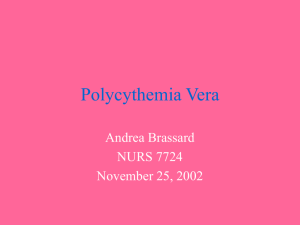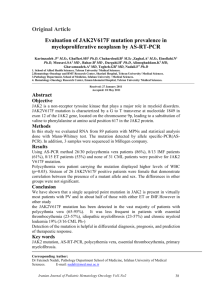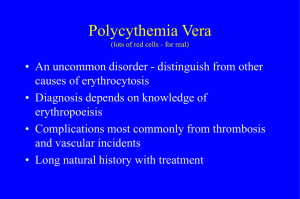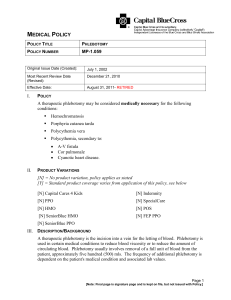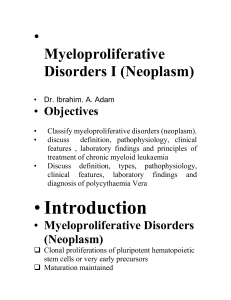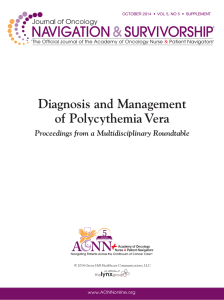Polycythemia Vera Kimberly Truong Wendy Yang |
advertisement
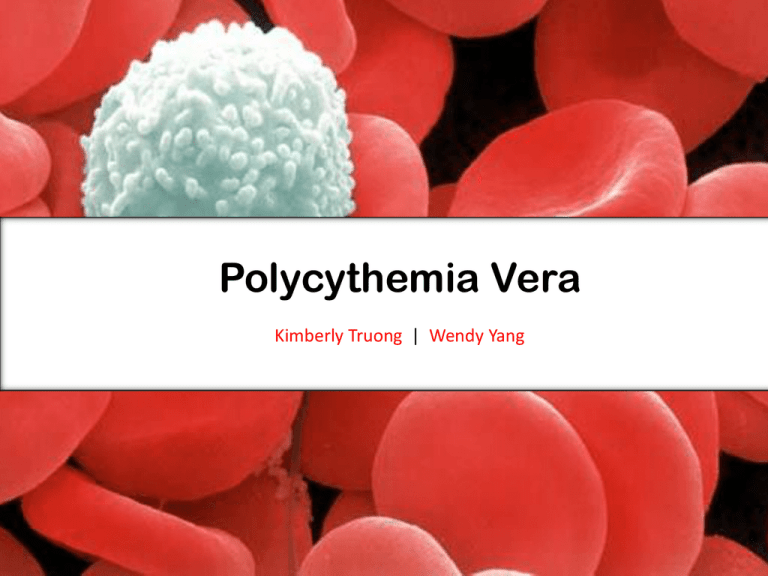
Polycythemia Vera Kimberly Truong | Wendy Yang Definitions • PVera: Increase in RBC mass with/without increase in granulocytes and platelets in the absence of physiologic stimulus • Hb is >16.5 (w) or >18.5 (m) • HCT >48 (w) or >52 (m) • Polycythemia/Erythrocytosis: Relative vs. absolute Etiology-Relative polycythemia • Dehydration • Stress erythrocytosis (Gaisbock's disease)chronically reduced plasma volume Etiology-Absolute polycythemia Secondary • +Reactive: increased EPO • EPO producing tumors – RCC, HCC, PCC, cerebellar, cushing’s • Hypoxemia: cardiopulmonary, OSA, altitude, RBC defects (smoking) • Anabolic steroids Primary • +Mutation • Pvera (JAK 2) • Chuvash polycythemia (VHL) • Other gene mutations Signs/Symptoms1 • Hyperviscocity: headache, dizziness, tinnitus, blurry vision • Thrombosis: transient vision disturbances, erythromalgia, budd chiari, DVT, MI, stroke • Bleeding: easy bruising, epistaxis • Pruritis, gout • Signs: HTN, plethora, splenomegaly Diagnosis-Revised WHO Criteria2 • Major criteria – Hemoglobin >18.5 g/dL in men, 16.5 g/dL in women – Presence of JAK2 617V>F or other functionally similar mutation such as JAK2 exon 12 mutation • Minor criteria – Bone marrow biopsy showing hypercellularity for age with trilineage growth (panmyelosis) with prominent erythroid, granulocytic, and megakaryocytic proliferation – Serum erythropoietin level below the reference range for normal – Endogenous erythroid colony formation in vitro • 2 major + 1 minor OR 1st major + 2 minor • Workup: – – – – – – H/H EPO SaO2 JAK2 screen (95-100% pts with PV have JAK2 mutation3) Bone marrow EEC: endogenous erythroid colony formation Work Up +Pvera features *increased red cell mass with SaO2≥92 percent, splenomegaly, thrombocytosis, and leukocytosis. -Pvera features Prognosis • Prognosis: – Untreated median survival: 6-18 months – Treated median survival: 13 years4 – Most common cause of death: • • • • • thrombosis (29 percent) hematologic malignancies (23 percent) non-hematologic malignancies (16 percent) hemorrhage (7 percent) myelofibrosis (3 percent) Treatment 1. Phlebotomy : goal Hct<42%/45%5 2. Low dose aspirin in all 3. Hydroxyurea if high risk of thrombosis (Age>60, prior thrombosis) 4. Symptomatic (allopurinol, antihistamines) • Responsiveness of treatment at 4.4 years:6 1. Complete response - 24% 2. Partial response - 66% 3. No response - 10% • No medication has been shown to improve survival or decrease risk of leukemic transformation in PV. References 1. Tefferi A, Rumi E, Finazzi G, Gisslinger H, Vannucchi AM, Rodeghiero F, Randi ML, Vaidya R, Cazzola M, Rambaldi A, Gisslinger B, Pieri L, Ruggeri M, Bertozzi I, Sulai NH, Casetti I, Carobbio A, Jeryczynski G, Larson DR, Müllauer L, Pardanani A, Thiele J, Passamonti F, Barbui T. Survival and prognosis among 1545 patients with contemporary polycythemia vera: an international study. Leukemia. 2013;27(9):1874. 2. Tefferi A, Thiele J, Orazi A, Kvasnicka HM, Barbui T, Hanson CA, Barosi G, Verstovsek S, Birgegard G, Mesa R, Reilly JT, Gisslinger H, Vannucchi AM, Cervantes F, Finazzi G, Hoffman R, Gilliland DG, Bloomfield CD, Vardiman JW. Proposals and rationale for revision of the World Health Organization diagnostic criteria for polycythemia vera, essential thrombocythemia, and primary myelofibrosis: recommendations from an ad hoc international expert panel. Blood. 2007;110(4):1092. 3. Scott LM. The JAK2 exon 12 mutations: a comprehensive review. Am J Hematol. 2011;86(8):668. 4. Tefferi A, Guglielmelli P, Larson DR, Finke C, Wassie EA, Pieri L, Gangat N, Fjerza R, Belachew AA, Lasho TL, Ketterling RP, Hanson CA, Rambaldi A, Finazzi G, Thiele J, Barbui T, Pardanani A, Vannucchi AM. Long-term survival and blast transformation in molecularly annotated essential thrombocythemia, polycythemia vera, and myelofibrosis. Blood. 2014 Oct;124(16):2507-13. Epub 2014 Jul 18. 5. Marchioli R, Finazzi G, Specchia G, Cacciola R, Cavazzina R, Cilloni D, De Stefano V, Elli E, Iurlo A, Latagliata R, Lunghi F, Lunghi M, Marfisi RM, Musto P, Masciulli A, Musolino C, Cascavilla N, Quarta G, Randi ML, Rapezzi D, Ruggeri M, Rumi E, Scortechini AR, Santini S, Scarano M, Siragusa S, Spadea A, Tieghi A, Angelucci E, Visani G, Vannucchi AM, Barbui T, CYTO-PV Collaborative Group. Cardiovascular events and intensity of treatment in polycythemia vera. N Engl J Med. 2013;368(1):22. 6. Barosi G, Mesa R, Finazzi G, Harrison C, Kiladjian JJ, Lengfelder E, McMullin MF, Passamonti F, Vannucchi AM, Besses C, Gisslinger H, Samuelsson J, Verstovsek S, Hoffman R, Pardanani A, Cervantes F, Tefferi A, Barbui T. Revised response criteria for polycythemia vera and essential thrombocythemia: an ELN and IWG-MRT consensus project. lood. 2013;121(23):4778. MKSAP-like Questions 1. A 66 year old male is evaluated for a 1-month h/o headache and blurred vision, early satiety, and itching that occurs after showering. He has a 90-pack-year smoking history. He has no history of cardiopulmonary or sleep disorders, no other medical problems, and he takes no medications. On exam, temp is nl, BP 160/90, HR 90, RR 18, BMI 35, SaO2 94% on ambient air. His face is erythematous and round. Cardiopulmonary and neurologic exam are normal. Abdominal exam +splenomegaly. Labs: Hb: 19g/dL WbC 13,500/uL w/ nl differentiation Plt 595,000 1. Which of the following is the most appropriate next step in diagnosis? A. B. C. D. BCR-ABL gene analysis Bone marrow biopsy Epo level Polysomnography PV Work Up +Pvera features *increased red cell mass with SaO2≥92 percent, splenomegaly, thrombocytosis, and leukocytosis. -Pvera features 2. The patient’s epo level was below normal range. You order a JAK2 mutation analysis which comes back (+) for an exon 14 JAK2 mutation. A diagnosis of PV is made. In addition to aspirin, which of the following is the most appropriate treatment for this patient? A. Phlebotomy only with goal Hct <42% B. Phlebotomy with goal Hct<42%, plus hydroxyurea C. Phlebotomy only with goal Hct <45% D. Phlebotomy with goal Hct <45%, plus hydroxyurea Treatment 1. Phlebotomy : goal Hct<42% (F) /45% (M)5 2. Low dose aspirin in all 3. Hydroxyurea if high risk of thrombosis (Age>60, prior thrombosis) 4. Symptomatic (allopurinol, antihistamines) 3. In addition to aspirin and hyroxyurea, the patient begins phlebotomy at 250cc of blood every other day until his hematocrit falls below 45%. During a follow-up appt, he states he is doing well with some mild pruritus. Followup labs show: – Ferritin: 10 (L) (nl: 15-200 μg/L) – Iron: 5 (L) (nl: 11-29 μmol/L) – Transferrin sat: 20% (L) Which is the most appropriate management of this patient’s new iron-deficiency state? A. B. C. D. Start oral iron therapy Start parenteral iron therapy Give 1u pRBC No intervention Since phlebotomy is effective in controlling polycythemia by producing a state of relative or absolute iron deficiency, iron supplementation should not be given. (In other words, you want the patient to be irondeficient. Iron deficiency indicates effective phlebotomy therapy.) 4. Five years later, the patient urgently presents to your clinic with severe RUQ pain and jaundice. On exam, you note scleral icterus, new mild hepatomegaly with RUQ tenderness to palpation and an abdominal fluid wave sign. AST: 250, ALT: 300, ALK PHOS: 300, TBili: 2.5 You send the patient to the ER and order stat imaging. What are you most concerned about? A. Autoimmune hepatitis B. Drug-induced hepatitis C. Budd chiari syndrome D. Acute cholecystitis • As many as 50 percent of all cases of the BuddChiari syndrome may be due to an underlying chronic myeloproliferative disorder (including PV) and an accompanying hypercoagulable state. – In a study with 163 budd chiari cases, the most common risk factor was myeloproliferative disorders • Darwish, et al. Etiology, management, and outcome of the Budd-Chiari syndrome. Ann Intern Med. 2009;151(3):167. • According to UpToDate: “We suggest that patients diagnosed with Budd-Chiari syndrome in whom no underlying disorder can be identified be tested for a JAK2 mutation." 5. The patient was treated appropriately for his Budd Chiari syndrome and was discharged home. The patient was doing well until five years later, he complained of slow-progressing fatigue. His Hb: 12.5, WBC: 14,400, Plt: 148. His peripheral blood smear is shown above. Bone marrow cannot be aspirated. Which of the following does this patient now have? A. Secondary myelofibrosis B. Essential thrombocytopenia C. Acute myelogenous leukemia D. Chronic myelogenous leukemia Life-time transformation rate in patients with PV • Polycythemia Vera Myelofibrosis: 20%4 • Polycythemia Vera AML/MDS: 7% • Polycythemia Vera CML: rare 4 Tefferi A, et al. Long-term survival and blast transformation in molecularly annotated essential thrombocythemia, polycythemia vera, and myelofibrosis. Blood. 2014 Oct;124(16):2507-13. Epub 2014 Jul 18.
